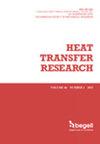Heat transfer enhancement behind an obstacle in a channel flow undergoing transition to turbulence
IF 1.6
4区 工程技术
Q3 THERMODYNAMICS
引用次数: 0
Abstract
Direct numerical simulation of heat transfer behind a spanwise obstacle was carried out in a steady channel flow. Reynolds numbers corresponded to transition to turbulence in the separation region behind the obstacle. The obstacle was mounted either on the channel wall or with a gap from the wall. Thorough verification of numerical results (visual flow pattern and flow statistics) against experimental data was carried out. Distributions of local coefficients of heat transfer and skin friction behind the obstacle were found to correlate with vortical structure of the flow. For both positions of the obstacle relative to the channel wall, the study discovered principal regularities in the behavior of local and averaged across the channel values of heat transfer behind the obstacle with the varying Reynolds number of the oncoming flow. The effect of obstacle position on the total increase in heat transfer coefficient on the wall behind the obstacle was estimated in comparison with the smooth wall.过渡到湍流的通道流中障碍物后的传热增强
在稳定的通道流中,对跨向障碍物后的传热进行了直接数值模拟。雷诺数对应于障碍物后分离区域向湍流的过渡。障碍物安装在通道壁上或与通道壁有间隙。根据实验数据对数值结果(可视流动模式和流动统计)进行了彻底验证。发现障碍物后的局部传热系数和表皮摩擦系数的分布与流动的涡流结构相关。对于障碍物相对于通道壁的两个位置,研究发现了障碍物后的局部传热系数和整个通道的平均传热系数随来流的雷诺数变化而变化的主要规律性。与光滑壁面相比,研究估算了障碍物位置对障碍物后壁面传热系数总增加值的影响。
本文章由计算机程序翻译,如有差异,请以英文原文为准。
求助全文
约1分钟内获得全文
求助全文
来源期刊

Heat Transfer Research
工程技术-热力学
CiteScore
3.10
自引率
23.50%
发文量
102
审稿时长
13.2 months
期刊介绍:
Heat Transfer Research (ISSN1064-2285) presents archived theoretical, applied, and experimental papers selected globally. Selected papers from technical conference proceedings and academic laboratory reports are also published. Papers are selected and reviewed by a group of expert associate editors, guided by a distinguished advisory board, and represent the best of current work in the field. Heat Transfer Research is published under an exclusive license to Begell House, Inc., in full compliance with the International Copyright Convention. Subjects covered in Heat Transfer Research encompass the entire field of heat transfer and relevant areas of fluid dynamics, including conduction, convection and radiation, phase change phenomena including boiling and solidification, heat exchanger design and testing, heat transfer in nuclear reactors, mass transfer, geothermal heat recovery, multi-scale heat transfer, heat and mass transfer in alternative energy systems, and thermophysical properties of materials.
 求助内容:
求助内容: 应助结果提醒方式:
应助结果提醒方式:


